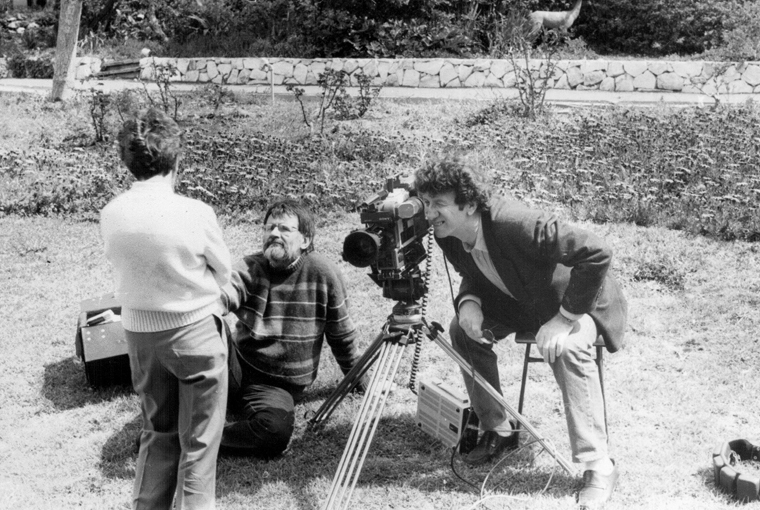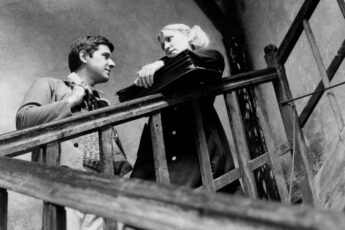Yugoslavia's Shoah
Danilo Kiš’s Bare Life (Goli život, 1990) in Retrospect
Vol. 132 (February 2023) by McKenna Marko
Despite being terminally ill with lung cancer, Yugoslav author Danilo Kiš arrived in Israel in 1989 with a small film crew to shoot a documentary series with two survivors of the Cominformist purges and Yugoslav corrective labor camps, the most notorious of which were located on the Adriatic islands of Goli otok and Sveti Grgur.1 The documentary was Kiš’s last work before his death later that year and bookended an oeuvre that obsessively confronted manifestations of state terror and violence in the 20th century.2
When two Yugoslav-Israeli emigres, Ženi Lebl and Eva Panić-Nahir, approached Kiš with their stories as he was visiting the Van Leer Institute in Jerusalem in 1986, he was initially hesitant to write about the camps. However, Lebl and Panić-Nahir felt that Kiš would be the ideal interlocutor for their testimonies and urged him to take on the task. Kiš decided instead to film the women in a documentary that would be, in his words, “our Shoah,” referring to Lanzmann’s groundbreaking 1985 Holocaust documentary. The documentary, Bare Life, would importantly break women’s decades-long collective silence on their experiences in the camps.3
The documentary’s title draws from the name of the island Goli otok, which means “bare” or “naked” island in B/C/S/M, to describe the brutal dehumanization of prisoners to “bare life”. It foreshadows the concept that the Italian philosopher Giorgio Agamben would use to describe the politicized bodies targeted for exclusion from the nation later that decade in his seminal work Homo Sacer (1995). Bare Life subsequently aired on Yugoslav television in 1990 as a four-part series. As coproducer Aleksandar Mandić recalls, Goli život was one of the last television programs that Yugoslavs would watch together as a nation, since by 1991, the nation had descended into civil wars that would result in its collapse by the end of the decade. The documentary represents the end of women’s collective silence about their experiences in an all-too-brief reckoning with the violent foundations upon which Tito’s multinational project was constructed. Today, the entire documentary series is impossible to locate, likely destroyed during the NATO bombing of Belgrade, with only a few extended clips now available on YouTube. Fortunately, 30 years after its release on television, Mandić published the full script in 2020, prompting a renewed interest in the film and the history of the women’s camps on Goli otok and Sveti Grgur.4 As I explore in this essay, Bare Life brings forth salient practices of memory that merit a return in the post-Yugoslav context for many reasons, two of which I focus on here. First is Bare Life’s critical consideration of the ways that other concentrationary histories can be approached after the Holocaust, and the second is its focus on gendered memories of Yugoslavia, which remain marginalized in post-Yugoslav official memory discourses.
Traitors of Nation and Party
Bare Life is filmed in Tel Aviv, Haifa, the Kibbutz Shaar Haamakim, as well as the adjacent beaches. Like Shoah, Bare Life conducts a form of contemporary witnessing devoid of archival footage, focusing instead on the testimonies of the two emigre women in the present. Unlike Shoah, however, it does not initiate returns to sites of violence.5 Instead, the background of the sea and beaches in Tel Aviv where several of the interviews take place, establishes a sense of topographical continuity while at the same time presenting a stark juxtaposition between their testimonies which recount the brutal conditions on the island camps and the leisurely act of sitting on the beach.
The two women are interviewed separately until the conclusion of the film, where they gather for some final remarks. As a whole, their testimonies give shape to the camps and the infrastructure of terror, paranoia, and misogyny that ensued in the wake of the Tito-Stalin split. In scenes from the documentary, Ženi Lebl and Eva Panić-Nahir recount to Kiš how they were transferred from the main prison in Belgrade, Glavnjača, and ferried across the Adriatic in a ship called the “Punat”. Imprisoned deep in the hold, the women didn’t know if it was day or night, Panić-Nahir clarifies. When they arrived, they were thrown into the water and forced to wade to shore, where they were confronted with the disorienting sound of women howling and shouting. They were then forced to “run the gauntlet,” where long-time prisoners beat them and hurled insults at them, accusing them of political delinquency and betrayal of Tito. As emerges over the course of the documentary, the women’s camps were maintained by internally imposed hierarchies: the “banda” referred to women who had not yet proven their self-correction, while the “brigade” referred to those who had proven their self-correction, most often through the beating and humiliation of women in the banda. Within the banda, there was yet another, much lower rank referred to as “bojkot”: prisoners who were boycotted were given even less food and water than usual, deprived of sleep, and forced to work 12 hours a day. Prisoners were tortured through physical labor, subjected to the “Sisyphean” task of hauling stones up and down a hill with no end goal in sight. Up until the creation of rape camps for Bosniak women during the Yugoslav dissolution wars, the women’s camps on Goli otok and Sveti Grgur were the most extreme manifestation of systematic misogyny and gendered violence: the vast majority of female prisoners were in their prime childbearing years, and the strenuous labor and malnutrition in the camps damaged many women’s reproductive capabilities that were so highly valued in a pronatalist society like the Socialist Federal Republic of Yugoslavia.6
Palimpsests of State Terror
While the documentary’s focus is on the two women interviewees, Kiš’s mediation of their testimonies is far from passive, and the dialogue is also influenced by Kiš’s personal interest in topics related to Jewishness, antisemitism, and identity, given his background as a child survivor of the Holocaust.7 While Kiš asks them whether they experienced antisemitism in Yugoslavia after the Holocaust, both Lebl and Panić-Nahir deny this, yet both women recall how the Yugoslav secret police, guards, and fellow prisoners in the camps singled them out as Jews. Simultaneously, they were accused of being fascist collaborators. Eva Panić-Nahir even recalls how she was forced to perform a Nazi march despite her protests that she was Jewish. The women both agree in their final conversation together that their victimizers used Jewishness and their suffering during the Holocaust to “hit a nerve,” in Lebl’s words, and distort their revolutionary biographies: if the rest of their family was murdered, how did they survive? They must have been collaborating with the Nazis, their interrogators intimated. “Why didn’t you emigrate to Palestine if you’re a Jew?”8
In this way, Bare Life not only focuses on Panić-Nahir’s and Lebl’s experiences in the camps but also their individual life histories, beginning with their early experiences as Yugoslav Jews, and touching on their engagement with the partisan movement and on how they survived the Holocaust. Lebl describes how she joined the partisan movement at 14, running away from home in Belgrade after the Nazi occupation of the city and witnessing a Nazi officer shoot their family dog. In Niš, she took the Serbian Orthodox name Jovanka Lazić. When she and other members of her brigade were captured after being informed on, they were handed over to fascist Bulgarian authorities, tortured and subjected to sexual violence. She was later transferred to prisons in Berlin, yet in the chaos of the Reich’s final days, she managed to avoid being discovered as a Jew and subsequently survived the war. Upon returning home to Belgrade in the newly established SFRY, she would learn that her mother perished in the gas vans driven from the Sajmište concentration camp. Eva Panić-Nahir tells Kiš that she grew up in a well-to-do Hungarian Jewish family in Čakovec, where she was surrounded by leftist intellectuals in her community and quickly got involved in the Communist party at a young age. At the outbreak of WWII, she married her first husband, Rade Panić, and joined the partisans, where she served as a courier among other roles. She would lose most of her family in Auschwitz-Birkenau by the end of the war. Thus, the dynamic between the women’s testimony and Kiš’s mediation helps forge a multilayered narrative that is embedded with several histories of violence, oppression, and bare life politics in the 20th century. In doing so, the documentary does not make a facile comparison between the Holocaust and corrective labor camps; instead, it teases out a constellation of concentrationary violence in which the nation functions as its central locus due to its constant search for Others.
Documentary as Auto-Recovery
The act of self-recovery initiated in Bare Life is particularly significant given the legacy of the anti-Stalinist purges and corrective labor camps that deconstructed revolutionary women’s autobiographies to reduce them to the identity of national and party traitors. The erasure of their former selves was enforced in the camps not only by physical labor and torture but also in “self-critiques,” whereby the women were forced to write out their biographies and the names of people that they knew to reveal their real and imagined enemy activities. This systematic distortion of their lives, in fact, irreversibly damaged revolutionary women’s sense of identity, self-worth, and life trajectories, which had formerly been grafted onto the national liberation movement and the promise of Yugoslavia’s progressive Socialist future. As Lebl would later recall, returning from the war had been much easier than returning from Goli otok and Sveti Grgur, because after the war there had been the collective desire to work for a better future, while after the island camps, all semblance of solidarity and hope had been shattered.9 Once a promising young journalist for the Belgrade-based newspaper Politika, Lebl was ousted by a male colleague who informed on her after she laughed at and retold a joke about Tito’s kilo of white violets, a joke playing off the well-known partisan song ‘Oh Comrade Tito, all the youth love white violets, all the youth love you…’ Having successfully removed his competition, this male colleague received a promotion and coveted foreign posting. Following her release from the camps, she entered a surveilled freedom enforced by the secret police and was faced with social stigmas surrounding political prisoners. When she returned to the newspaper to reclaim a job, the editor exclaimed, “you…. you’re not a person, you’re worse than war criminals.”10 She began to drink heavily, even considering suicide until she was granted permission to emigrate to Israel.
Eva Panić-Nahir, in turn, was arrested following her husband’s arrest and subsequent suicide, her only crime being her refusal to denounce her husband as a traitor. This decision landed her a prison sentence on the island camps and severed her relationship with her daughter, Tijana, who did not forgive her mother for her early abandonment.11 Like Ženi Lebl, Eva Panić-Nahir found it impossible to assimilate back into Yugoslav society after the camps, suffering physically and psychologically, and she, too, later emigrated to Israel. Exacerbated by the misogynistic politics that led to women’s imprisonment and their continued loss of social agency in a patriarchal Yugoslav political sphere,12 women were thus subjected to a form of social death that barred their physical and symbolic reentry back into society.
The camps on Goli otok and Sveti Grgur were first and foremost designed as a place for disappearing undesirable and delinquent bodies during a time of real and imagined threats to state security. They were not intended for the purpose of mass death, yet some women did not return from the camps, their deaths concealed from their families for many years, while for survivors like Ženi Lebl and Eva Panić-Nahir, their lives were forced into symbolic oblivion by the state. The erasure of women’s identities compounded with their limited social agency in comparison to men in Yugoslav society enforced their long-held silences regarding their experience.13
Bare Life seeks to counter women’s dehumanization and erasure by providing the women space to become witnesses, their testimonies generating the documentary’s narrative. All that we are to learn about the camps in this documentary comes from Panić-Nahir’s and Lebl’s memories. While Kiš does prompt the women to remember specific details, we also have to accept that there are things that will be left unsaid and that these silences are also significant to understanding women’s experiences of state terror. It is clear from Lebl’s memoir, White Violets (1990), which she published following Kiš’s encouragement, that there were certain traumas she did not feel ready to broach during the filming of the documentary, such as being raped by a male doctor whom she approached for medical care. In the documentary film, the trauma and violence of the camps are imparted via the embodied layers of women’s testimonies, such as heightened emotions and body language, or even expressions of disbelief. Eva Panić-Nahir, in particular, is a lively narrator, as can be gleaned from the segments of the documentary online. Unfortunately, these embodied layers are what is omitted when reading the script in the absence of the full documentary.
The role of testimony is to address another, something that Shoshana Felman sees as the essential link between testimony and memory.14 Possible at first only through a male mediator – a reflection of (post)Yugoslavia’s patriarchal memory regime with its system of closed doors and male permission that precluded women from producing memory on their own,15 – Bare Life ultimately gives women the chance to produce collective memory of state terror. While female solidarity was foreclosed in a camp system that functioned via internal hierarchies and the beating of and spying on other prisoners, Lebl’s and Panić-Nahir’s testimonies reclaim women’s collective agency as political and social subjects. While film scholars and critics often focus on filmmakers’ interventions in official histories as a result of their investigative work,16 the fact that Lebl and Panić-Nahir persuaded Kiš to interview them and assist them with the transfer of difficult individual memories to public knowledge differentiates Bare Life from other testimonial documentaries. Namely, the narrative of Shoah and many other documentary films following its example, is initiated by a “narrator” or interviewer who coaxes interviewees to share their testimonies. Furthermore, in Shoah, these interviewees are solely male, as the Holocaust scholars Marianne Hirsch and Leo Spitzer have rightly pointed out, arguing that the women in the film are reduced to linguistic go-betweens, background roles (the weeping women), and affective objects in the men’s testimonies.17 By contrast, Bare Life begins a necessary process of reconfiguring the power dynamics between interview and interviewee and the voice of male authority to reassert women’s visibility and agency as witnesses and producers of historical narrative.
Films operate as performative technologies of memory, that is, media that produce memory and intervene in official narratives. Yet, films are objects of memory in their own right that generate continued discourse and engagement that persist even in the absence of the film, as demonstrated by Bare Life’s disappearance after the Yugoslav dissolution wars. Followed by a wave of women’s autobiographical accounts and testimonies in the 1990s and 2000s made possible by Lebl and Panić-Nahir’s breaking of the silence in Bare Life, the women’s testimonies onscreen allow them to dissolve the patriarchal barriers that had denied them a space in (post)Yugoslavia’s official memory. They reclaim their political and social agency and counter their dehumanization by recovering lives physically and symbolically destroyed in multiple iterations of state violence.
References
- 1.When Yugoslavia broke with the Soviet Union in 1948, a period of repressive de-Stalinization ensued, during which the Yugoslav secret police (UDBA) purged the Communist party of real and imagined Stalinist supporters and political enemies. The purges resulted in a series of arrests and the creation of prisons and corrective labor camps throughout Yugoslavia. On the islands of Goli otok and Sveti Grgur, around 17,000 men and 860 women were imprisoned from 1949 to 1956 (Jambrešić-Kirin , R. (2014). Yugoslav Women Intellectuals: From a Party Cell to a Prison Cell. In: History of Communism in Europe (5), 36-53; 39).
- 2.Beganović, D. (2007). Pamćenje Traume. Apokaliptička proza Danila Kiša. Zoro: Zagreb.
- 3.Mandić, A. (2020). Goli zivot (transcript). Yes Pro Media Company: Belgrade; 7.
- 4.See Mandić 2020.
- 5.The return journey to sites of one’s personal and collective trauma is the main focus of a 2002 Israeli documentary featuring Eva Panić-Nahir, her daughter Tijana and granddaughter Emily.
- 6.Jambrešić-Kirin, R. (2010). Izdajnice su uvijek ženskog roda: političke zatvorenice u arhipelagu Goli. In: UP & Underground (17-18), 232-242. Jambrešić-Kirin , R. (2007). Šalje Tito svoje na ljetovanje! ženska trauma i Arhipelag Goli. Treća, 1(IX), 9-38.
- 7.Danilo Kiš was born in 1935 in the multiethnic borderland of Vojvodina in Subotica to a Hungarian Jewish father and Montenegrin mother. He later moved with his family to Novi Sad, where they witnessed the 1942 massacre of Jewish, Serbian, and Roma citizens in Novi Sad at the hands of the occupying Hungarian army, from where the family fled to Southern Hungary. Kiš, his sister, and his mother would survive the war, though his father was deported to Auschwitz-Birkenau, a fact that Kiš only learned much later as an adult. His early trilogy Garden, Ashes, Early Sorrows and Hourglass is a semi-autobiographical reflection on his childhood in Vojvodina and the Holocaust.
- 8.Mandić 2020, 120.
- 9.Lebl, Ž. (1990). Ljubičica bela: vic dug dve i po godine. Gornji Milanovac: Dečje novine.
- 10.Mandić 2020, 115.
- 11.The damaged mother-daughter relationship between Tijana and Eva is the subject of the Israeli documentary Eva (dir. Macabit Abramson & Avner Faingulernt, 2002).
- 12.This loss of political agency was marked firstly by the depoliticization of feminist organizations, notably the Antifašištički front žena (AFŽ) that (self)disbanded due to pressure from a political climate that claimed that full gender equality had been achieved with the establishment of the worker’s state.
- 13.Jambrešić-Kirin 2014. There are various other contributing factors to women’s silence as well.
- 14.Felman, S. (2000). In an Era of Testimony: Claude Lanzmann’s Shoah. Yale French studies (Vol. 97), 103-150. Yale UP.
- 15.Matijević, T. (2020) “Women’s Writing and Critical Nostalgia: On Ildiko Lovas’ Fiction.’’. In: From Post-Yugoslavia to the Female Continent A Feminist Reading of Post-Yugoslav Literature. Bielefeld: Transcript Verlag.
- 16.See also for insights on the subject of testimony and memory in documentary film: Waterson, R. (2007). “Trajectories of Memory: Documentary Film and the Transmission of Testimony’’. In: History and Anthropology (18:1), 51-73.
- 17.Hirsch, M. & Spitzer, L. (2014). “Gendered Translations: Claude Lanzmann’s Shoah’’. In: Cooke, M. .G. & Woollacott, A. (Eds), Gendering War Talk. Princeton: Princeton UP, 1-25.




Leave a Comment